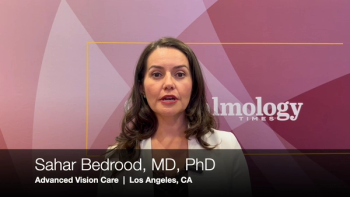
Photoscreening could detect vision-threatening conditions in early childhood
Regular vision screening assessments in early childhood have been shown to reduce the risk of persistent amblyopia at 7 years of age by more than half, according to a recent retrospective record review.
Editor’s Note: Welcome to “Let's Chat,” a blog series featuring contributions from members of the ophthalmic community. These blogs are an opportunity for ophthalmic bloggers to engage with readers with about a topic that is top of mind, whether it is practice management, experiences with patients, the industry, medicine in general, or healthcare reform. The views expressed in these blogs are those of their respective contributors and do not represent the views of Ophthalmology Times or UBM Medica.
Regular vision screening assessments in early childhood have been shown to reduce the risk of persistent amblyopia at 7 years of age by more than half.1,2
To better the clarify the role of vision screening in primary-care offices, in 2016, the
The report notes the availability and extensive validation of device-based screening in field studies and in the office.3-8 The AAP states that screening instruments detect amblyopia, high refractive error, and strabismus, the most common conditions that produce visual impairment in children.1,2,9
Although they can be used at
The AAP concludes: “Using these techniques in children younger than 6 years can enhance detection of conditions that may lead to amblyopia and/or strabismus compared with traditional methods of assessment.”1
On the heels of the AAP direction, the U.S. Preventive Services Task Force released a statement supporting device-based screening technologies for preschool vision screenings with a level B evidence rating.11 The Affordable Care Act requires that health plans fully cover preventive services that have an A or B rating (CPT code 99177 for an immediate result in office, CPT 99174 for remote interpretation).
Oregon Elks experience
The Oregon Elks Children’s Eye Clinic began using photoscreening exclusively in 2013 for its Preschool Vision Screening Program which focuses on detecting amblyopia. The Oregon state legislature mandates that all children entering school show proof of a vision screening, and the Elks program provides free photoscreening using the plusoptiX S.12
Through the program, data on 7,551 children were collected in 2017-18; 12.3% were referred for a complete eye examination. Of the children referred, 108 cases of amblyopia were diagnosed. In 2017 in the Elks program, 87.8% of the children who were referred received treatment.
A recent retrospective record review found that the most common reason for overreferral in the Elks program was astigmatism when using a 1.50 D referral criterion with the plusoptiX.12 When the setting was changed to 2.25 D, the false positives were reduced by 34%.
Overall, the program’s database contains more than 50,000 scans, and notes from follow-up eye examinations are analyzed to determine the accuracy of screenings. The Elks program’s well-developed follow-up component ensures that 62% of children identified for referral have a follow-up examination; a rate of 46% has been reported elsewhere.13
Conclusion
Photoscreeners like the plusoptiX estimate refractive error, media clarity, ocular alignment, and eyelid positions. Abnormalities in these characteristics are risk factors for the presence or development of amblyopia, which, when left untreated, is the most frequent cause of preventable vision loss in children. Although there appears to be broad awareness of the importance of childhood vision screening, only about 40% of pre-kindergarten children in the United States are screened.14-16
Photoscreening takes less than a minute, and it requires less attention and cooperation from the child compared with traditional visual acuity screening. The Oregon Elks Preschool Vision Screening Program achieves high-quality vision screening referrals using photoscreening and well-validated criteria. Because not all school-age children will need a complete eye examination, photoscreening is a cost-effective method for identifying those who do.
Disclosures:
Joannah Vaughan, MBA, is founder and director of the Elks Preschool Vision Screening Program and instructor of ophthalmology at the Elks Children’s Eye Clinic, Oregon Health & Science University, Casey Eye Institute. She may be reached at (503) 545-8115; [email protected].
Daniel J. Karr, MD, is director of the Oregon Elks Children’s Eye Clinic, a professor of ophthalmology and Elks of Oregon Professor of Pediatric Ophthalmology, School of Medicine, Oregon Health & Science University, Casey Eye Institute. He may be reached at [email protected].
Talitha Dale is the follow-up coordinator of the Elks Preschool Vision Screening Program and instructor of ophthalmology at the Elks Children’s Eye Clinic, Oregon Health & Science University, Casey Eye Institute. She may be reached at [email protected]. None of the above authors have financial disclosures.
References:
1. Committee on Practice and Ambulatory Medicine, Section on Ophthalmology, American Association of Certified Orthoptists, American Association for Pediatric Ophthalmology and Strabismus, American Academy of Ophthalmology. Visual system assessment in infants, children, and young adults by pediatricians. Policy Statement. Pediatrics. 2016;137(1). doi: 10.1542/peds.2015-3596.
2. American Academy of Pediatrics. Section on Ophthalmology; American Association for Pediatric Ophthalmology and Strabismus; American Academy of Ophthalmology; American Association of Certified Orthoptists. Procedures for the evaluation of the visual system by pediatricians. Pediatrics. 2016;137(1). doi: 10.1542/peds.2015-3597.
3. Longmuir SQ, Boese EA, Pfeifer W, Zimmerman B, Short L, Scott WE. Practical community photoscreening in very young children. Pediatrics. 2013; 131(3). Available at: www.pediatrics.org/cgi/content/full/131/3/e764.
4. Longmuir SQ, Pfeifer W, Leon A, Olson RJ, Short L, Scott WE. Nine-year results of a volunteer lay network photoscreening program of 147 809 children using a photoscreener in Iowa. Ophthalmology. 2010;117(10):1869-1875.
5. Bloomberg JD, Suh DW. The accuracy of the plusoptiX A08 photoscreener in detecting risk factors for amblyopia in central Iowa. J AAPOS. 2013;17(3):301-304.
6. Ransbarger KM, Dunbar JA, Choi SE, Khazaeni LM. Results of a community vision-screening program using the Spot photoscreener. J AAPOS. 2013;17(5):516-520.
7. Salcido AA, Bradley J, Donahue SP. Predictive value of photoscreening and traditional screening of preschool children. J AAPOS. 2005;9(2):114-120.
8. Halegoua J, Schwartz RH. Vision photoscreening of infants and young children in a primary care pediatric office: can it identify asymptomatic treatable amblyopic risk factors? Clin Pediatr (Phila). 2015;54(1):33-39.
9. Donnelly UM. Horizontal strabismus worldwide-what are the risk factors? Ophthalmic Epidemiol. 2012;19(3):117-119.
10. Donahue SP, Johnson TM. Age-based refinement of referral criteria for photoscreening. Ophthalmology. 2001;108(12):2309-2314, discussion 2314–2315.
11. US Preventive Services Task Force. Vision screening for children 1 to 5 years of age: US Preventive Services Task Force Recommendation statement. Pediatrics. 2011;127(2):340–34 .
12. Vaughan J, Dale T, Herrera D, Karr D. Oregon Elks Children's Eye Clinic vision screening results for astigmatism. J AAPOS. 2018;22(3):207-210. doi: 10.1016/j.jaapos.2018.01.012.
13. Su Z, Marvin EK, Wang BQ, et al. Identifying barriers to follow-up eye care for children after failed vision screening in a primary care setting. J AAPOS. 2013;17(4):385-390. doi: 10.1016/j.jaapos.2013.05.008.
14. Donahue SP, Arthur B, Neely NE, et al; POS Vision Screening Committee. Guidelines for automated preschool vision screening: A 10-year, evidence-based update. J AAPOS. 2013;17:4-8.
15. Chou R, Dana T, Bougatsos C. Screening for visual impairment in children ages 1–5 years: update for the USPSTF. Pediatrics. 2011;127(2): e442–e479.
16. American Academy of Pediatrics (2008). Recommendations for preventive pediatric
health care. In Bright Futures: Guidelines for Health Supervision of Infants, Children, and Adolescents, 3rd ed., p. 591. Elk Grove Village, IL: American Academy of Pediatrics.
Newsletter
Don’t miss out—get Ophthalmology Times updates on the latest clinical advancements and expert interviews, straight to your inbox.



















































.png)


